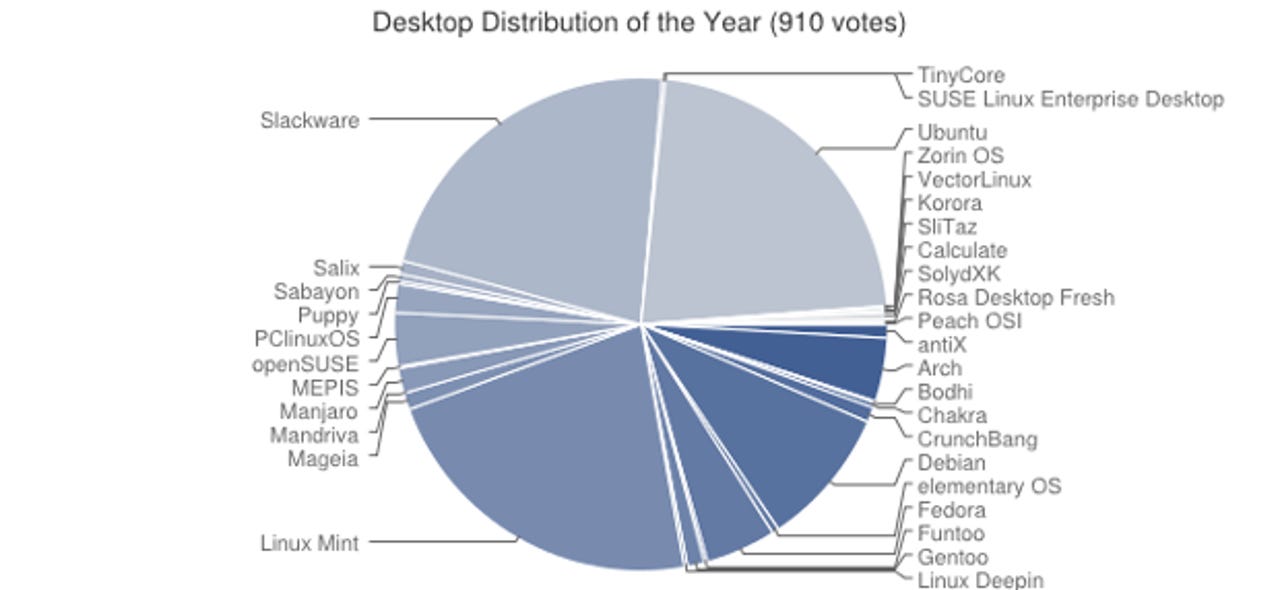The best open-source software for serious Linux users

Everyone has their personal favorite programs, but some users are more serious about their software than others. One such group includes the people at LinuxQuestions. These are Linux experts who are kind enough to answer newbies' endless questions. So when they pick out their favorite Linux distributions and open-source programs, I take their opinions seriously.

Linux desktop
The best Linux desktop of the year was declared a three-way tie by Jeremy Garcia, founder of LinuxQuestions and LQ Consulting, an open-source software consulting business. The winners were Linux Mint and Ubuntu, two Linux distributions that even casual Linux fans know of, and one, Slackware, that only Linux professionals are likely to know of. Slackware, the creation of Patrick Volkerding, is one of the oldest Linux distributions. It was first compiled in 1993.
I can agree with this selection. Personally, Linux Mint is my favorite desktop operating system, and I like Ubuntu. I've never been a serious Slackware fan, but with its Unix look and feel, I can see why it's still the first choice for many serious, old-school Linux/Unix users.
Linux desktop environment
KDE proved to be the winner here, with 34 percent of the vote. That was to be expected. KDE has always been one of the big two Linux desktop environments. What was surprising was that its long-time rival, GNOME, has fallen to a virtual tie with my only pick for the best desktop environment, Cinnamon. Ahead of them both and in second place overall was Xfce, an old but often overlooked lightweight desktop.AR + VR
GNOME has been going downhill since 2011, but I hadn't realized just how much its popularity has eroded over the last few years.
Web browser
I was startled to find that Firefox was overwhelmingly the most popular Linux desktop web browser, with 58 percent support. True, Firefox is still the default web browser in most Linux distros, but I thought Chrome, my own browser pick on any operating system, would be at least neck and neck with Firefox. I was wrong. Chrome is in second place, but it's a long, long way back from Firefox.
Office suite
Another interesting choice was LibreOffice. This program also beat the stuffing out of its rivals, with 86 percent of the vote. Ever since LibreOffice forked from OpenOffice, I thought LibreOffice would prove to be far more popular than OpenOffice. I just didn't expect it to be so much more popular than its parent program so soon.
Messaging and VoIP applications
Any Linux desktop user would expect Pidgin to be the top IM client. It's easy, and it works with essentially all IM programs.
What may shock even some Linux users is what has turned out to be the top VoIP program: Microsoft Skype. Yes, that's right: First, Microsoft makes a Skype for Linux, and second, with 46 percent of users, it's easily the most popular Linux VoIP program.
I don't quite get this, myself. I rely on Google Voice and Hangouts, but there it is: Skype's number one on Linux as well as Windows. Who knew?
Mobile OS
There can be no shock at all that Android is the number one mobile Linux operating system. Firefox OS, Tizen, Ubuntu, etc are all trying to gain mind share, but they haven't been successful. It's really that simple.
Linux server OS
The top pick here is no surprise. With 32 percent of the vote, it was the free Red Hat Linux Enterprise clone CentOS. This server operating system has always been popular, especially with web-hosting sites and datacenters, since it combines Red Hat's quality for experienced administrators who don't need Red Hat's support.
Behind CentOS, you'll find few surprises. The next three distributions are Slackware, Debian, and Ubuntu. I use CentOS myself for my main website, Practical Technology. I was surprised to see openSUSE, which I use for my internal servers, RHEL, and SUSE Linux Enterprise Server (SLES) ranking as low as they were. In the enterprise, RHEL rules and SLES still plays an important rule in some big businesses.
Database
Once upon a time, there was no question about what the top open-source database management system (DBMS) was. It was MySQL, no ifs, ands, or buts. Things have changed.
Today, the top DBMS pick is MariaDB. Since MariaDB was forked from MySQL in 2012, it has rapidly gained popularity. MySQL still has its supporters, but PostresSQL has supplanted it for second place.
I recently switched to MariaDB myself, and I have to say that I really like it. It really is a drop-in replacement for MySQL, except it runs quicker and puts less of a burden on my servers.
Cloud
This produced perhaps the most interesting result. Instead of OpenStack, CloudStack, or Eucalyptus emerging on top, the small-scale ownCloud was at the summit, with over half the vote. OpenStack did place second, with the others far behind.
For the rest of the results, see the LinuxQuestions website. I will give one last result: In the eternal battle between vi and EMACS for the top text editor, I'm pleased to report that vim, a vi variant, handily beat EMACS as the most popular text editor -- as it should have!
Related stories:
- Best Linux desktop of 2014: Linux Mint 17.1
- The best open-source office suite, LibreOffice 4.4, gets new release
- Why MariaDB says MaxScale will make life easier for developers and admins
- Open-source IaaS: OwnCloud 7 Enterprise Edition arrives
- CentOS 7 to be released shortly
- Setting up Linux Mint 17.1 for the first time